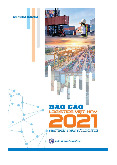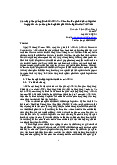



















Preview text:
World-Class Warehousing and Material Handling
This page intentionally left blank World-Class Warehousing and Material Handling
S E CO N D E D I T I O N Edward H. Frazelle, PhD
New York Chicago San Francisco Athens London
Madrid Mexico City Milan New Delhi Singapore Sydney Toronto
Copyright © 2016 by Edward H. Frazelle, PhD, and RightChain(TM) Incorporated. All rights
reserved. Printed in the United States of America. Except as permitted under the United States
Copyright Act of 1976, no part of this publication may be reproduced or distributed in any
form or by any means, or stored in a database or retrieval system, without the prior written permission of the publisher.
1 2 3 4 5 6 7 8 9 0 DOC/DOC 1 2 1 0 9 8 7 6 ISBN 978-0-07-184282-2 MHID 0-07-184282-9 e-ISBN 978-0-07-184283-9 e-MHID 0-07-184283-7
Library of Congress Cataloging-in-Publication Data Names: Frazelle, Edward.
Title: World-class warehousing and material handling / by Edward Frazelle.
Description: 2 Edition. | New York : McGraw-Hill Education, 2015. | Revised
edition of the author’s World-class warehousing and material handling, 2002.
Identifiers: LCCN 2015032909 | ISBN 9780071842822 (alk. paper) | ISBN 0071842829 (alk. paper)
Subjects: LCSH: Warehouses—Management. | Materials handling.
Classification: LCC HF5485 .F69 2015 | DDC 658.7/85—dc23 LC record available at
http://lccn.loc.gov/2015032909
RightHouse™, RightViews™, RightScores™, RightIns™, RightPuts™, RightStore™, RightPick™,
RightSlot™, RightShip™, RightPaths™, and RightComms™ and related terms are trademarks of RightChain™ Incorporated.
McGraw-Hill Education books are available at special quantity discounts to use as premiums
and sales promotions or for use in corporate training programs. To contact a representative,
please visit the Contact Us pages at www.mhprofessional.com.
This book is dedicated to my Lord, Savior, and Best Friend Jesus Christ, Who
blessed me with the experiences and abilities to share these learnings; to my
beautiful wife Pat, who has patiently allowed me to have these experiences and
encouraged me in them; and to Kelly, Andrew, and Travis.
This page intentionally left blank C O N T E N T S Acknowledgments ix CHAPTER 1 Introduction toWarehousing 1 CHAPTER 2
WarehouseActivity Profiling, Data Mining, andPatternRecognition 21 CHAPTER 3
Warehouse Performance, Cost, andValue Measures 75 CHAPTER 4
World-Class Receiving and Put-away 109 CHAPTER 5
Pallets: Pallet Storage and Handling Systems 135 CHAPTER 6 Case Picking Systems 181 CHAPTER 7 Broken Case Picking Systems 215 vii viii Contents CHAPTER 8 Order Picking andShipping 257 CHAPTER 9 Warehouse Layout Optimization 291 CHAPTER 10
Warehouse Communication Systems 315 Index 345
A C K N O W L E D G E M E N T S
Mr. Jun Suzuki is the patriarch of Japanese logistics. We met during my first
logistics study tour in Japan in 1988. He has been my logistics mentor ever
since. Many of the pictures of Japanese and European warehousing opera-
tions come from his extensive photo gallery of warehousing operations.
My wife Pat has been my writing partner from the time I wrote my
master’s thesis. She is brilliantly gifted in editing for an audience, and is a
God-send of a life and writing partner.
My son Andrew is currently finishing his doctorate in Decision Sciences
at Duke University. I think he was also born a linguist, and he implores me
to choose my words carefully. Though humbling, his editing was an invalu-
able contribution to the book. He is a God-send of a thought, research and analytics partner.
World-Class Warehousing is illustrated with more than one hundred
photos taken inside some of the world’s best warehouse operations. Those
long time clients and study tour partners include American Cancer Society,
Avon, Bertelsmann, BIC, Boots, BP, Caterpillar, Coca-Cola, Ford, Happinet,
Honda, L.L. Bean, KAO, Kirin, K-Mart, Lifeway, Marks & Spencer, Metro,
Mitsubishi, Netto, Nike, NTT, NuSkin, Payless, Otto, Oxxo, Scroll, Shiseido,
Sony, Suntory, Swagelok, Rio Tinto, Rittal, the United States Armed Services,
and Verizon. They have been very accommodating to share their experiences in warehousing and logistics.
The RightChain™ principals around the world—Dr. Matt Anderson,
Angel Becerra, Henry Brunekreef, Matsukawa-san, Masaji Nakano, Ricardo
Sojo, and Mary Wong—continually encourage my research, teaching, and writing. ix x Acknowledgements
In our consulting and training, we have been blessed to work with some
of the world’s best and brightest individuals and corporations. They have
encouraged and supported me to no end. ■
Steve Laky, Rick Glasson and Abbott. ■
Bill Costa and American Cancer Society. ■
Steve Spiva, Jack Gross, and Applied Materials. ■
Jane Houze, Bill Hightower and AT&T. ■
Roosevelt Tolliver, Jim Lofgren and Avon. ■
Carliss Graham, Greg Otter, Durwood Knight, Richard
McCrosky, Raylene Morris, Caroline Thompson and BP. ■ Diane Mullican and Carrier. ■
Dave Hopkins, Steve Westphal, Kevin Fox, Ted Bozarth, Brett
Frankenburg and Coca-Cola Consolidated. ■
John Sibilia, Josue Munoz and Colgate. ■
Lynn Barratt, Steve Erbe, Carmen Guerero, Karen Hall, Tom
Nabie, Bruce Terry, Hal Welsh and Disney. ■ Dan Krouse and Hallmark. ■
Sean Garrett, Dave Eidam and Hamilton Sunstrand. ■
Jim Roach, Chuck Hamilton, Bruce Smith, Juan Streeter, Kathy Howell and Honda. ■
Tammy Ryan, Jim Sylvester and H.P. Hood. ■ Dave Wilford and Invitrogen. ■
Debbie Postle and LAM Research. ■
Dave Lavesque, Jim Pierce, Tom Galanti and LiDestri. ■ Mike Harry and Lifeway. ■ Susan McLain and LL Bean. ■
Carlos, Rodrigo, Ignacio and Mas X Menos (now Wal-Mart Central America). Acknowledgements xi ■
Lou Arace, Dave Burton and Nutrisystem. ■
Jorge, Carlos, Miguel, Nelly, Sergio, Rafael, Bernie, Eduardo, Paulina, and Oxxo. ■
Daryl Pavelqua, Mary Boatright, James Wichern and Payless. ■
Danny DiPerna, Rob Grossman, Kathy Godin, Ed Delmastro, Bill
Kelly, Andy Minor and Pratt & Whitney. ■
Mark Ward, Frank Encinas, and Raytheon. ■
Scott Singer, Russell Hodson and Rio Tinto. ■ David Phillips and Rittal. ■
Sean Stucker, Bill Burgess, Greg Flack, Greg Olson and Schwan’s Food Company. ■
Eric Eber, Mike Graska, Matt LoPicolo and Swagelok. ■
Rex Taylor and Taylor Logistics. ■
Sam Campagna, Jackie DeMatos, Jan Salewski, Scott Singer and United Technologies. ■
Matt Anderson, Ouris Pellegrin and the U.S. Army and MarineCorps.
This page intentionally left blank World-Class Warehousing and Material Handling
This page intentionally left blank C H A P T E R O N E INTRODUCTION TOWAREHOUSING
1.1 Warehousing Through the Years 1.2 Warehousing Fundamentals 1.3 How to Read This Book
I wrote the first edition of World-Class Warehousing in 1995. Back then,
people asked me why I was writing a book on warehousing when the
just-in-time (JIT) movement was aimed at eliminating warehousing.
Today, it’s the lean movement. The question is a legitimate one and one
I ask seminar attendees every time I teach a warehousing seminar. “Why
should we devote our time and energy to studying an activity that every
supply-chain professional and the lean literature is trying to eliminate?”
A better question might be, “In what ways does warehousing add value in
business and in supply chains?” If we can’t come up with good answers,
then writing this book really was a waste of time, and reading it likewise.
As we will see, warehousing plays an indispensable role in business and supply-chain strategy. 1 2
World-Class Warehousing and Material Handling
Warehousing in the Supply Chain
I developed the RightChain model in the mid-1990s. The model integrates
and optimizes walks through the five components of supply chain strategy:
customer service, inventory management, supply, transportation, and ware-
housing. Through those eyes, the value of warehousing is demonstrated in
each component clearly visible (Figure 1.1).
Warehousing and Customer Service
Warehousing adds value in customer service, by facilitating high inventory
availability, shorter response times, value-added services, returns, custom-
ization, and consolidation among others.
Fill rate is the portion of a customer’s demand satisfiable from on-hand
inventory. In most cases, a significant investment in safety stock is required
to provide high customer fill rates. That safety stock must be housed some-
where, and that somewhere is typically a warehouse.
Warehouses in close proximity to the customer base and with short
internal cycle times help to reduce response times to customers. We have
one client that provides same-day delivery of critical service parts via a
Figure 1.1 RightChain supply-chain logistics model. RightServeTM RightHouseTM RightChainTM M M T s ckT p i r T t tSto h h g i ig R R RightBuysTM
CHApTER ONE INTRODUCTION TOWAREHOUSING 3
nationwide network of small warehouses with short order cycle times. One
of our financial services clients supports its financial analysts with small
warehouses located in the centers of major financial districts, serving offices
via subway, courier, walking, and bicycles. One of our convenience store
clients is improving product freshness by increasing delivery frequencies to
its 14,000 stores supported by a major increase in the number and capacity
of its warehouses and distribution centers.
Following the mass customization movement, the likelihood that an
order will require customization in some form is increasing exponentially.
The ability to execute the requisite value-added services such as custom
labeling, special packaging, monogramming, kitting, coloring, and pricing is
and will continue to be a competitive supply-chain differentiator. Warehouses
are uniquely equipped with the workforce and equipment to execute these
value-added services. In addition, by holding the noncustomized inventory
and postponing the customization, overall supply chain inventory levels
may be reduced. As the physical facility closest to the customer location, a
warehouse is also a natural place to customize, kit, assemble, or countrify
products in accordance with the principle of postponement—minimizing
overall inventory investments throughout a logistics network by delaying
customization. For example, one of our health and beauty aids clients puts
its shampoo in blank bottles for storage. Once an order is confirmed from
a specific country, the labeling required for that specific country is applied
in line with the picking and shipping process.
One customer service is foundational to our culture’s expectations of
logistics systems but taken for granted is consolidation .For example, if you
order a shirt and a pair of pants from a mail-order company, rarely would
you want the shirt showing up one day in one package and the pants show-
ing up another day in another package. For those items to show up at the
same time in the same package, they most likely need to be housed under
the same roof, that is, in a warehouse. 4
World-Class Warehousing and Material Handling
Returns constitute another customer service facilitated by good ware-
housing practice. Convenient and inexpensive returns for customers yield
higher sales and customer satisfaction ratings. Warehouses and distribution
centers are typically already located in close proximity to the customer base
and have the workforce and material-handling equipment uniquely suited to handling returns.
Although not directly considered a customer service, in many parts of
the world, physical market presence is an important cultural competitive dif-
ferentiator. Warehouses and distribution centers are well-recognized means
of establishing physical market presence.
Warehousing and Inventory Management
Because warehouses house inventory (or wares), warehousing adds business
and supply-chain value in all the same ways as inventory. Warehouses and
their inventory facilitate production economies of scale, optimize factory
utilization via seasonal inventory builds, and mitigate supply-chain and busi-
ness risk by holding contingency and disaster inventory. Despite all efforts
to reduce setup and changeover costs and time, there will always remain
expensive and time-consuming setups. In those situations, it would be eco-
nomically foolish to produce short runs. When long production runs are
economical, the resulting lot-size inventory must be housed, most effectively
in a warehouse. For example, one of our large food and beverage clients was
running lot sizes 50 percent below optimal, incurring excessive changeover
and production costs as a result. To correct, an additional 150,000 square
feet of warehousing space was required, yielding a significant return on
investment to their business Figure 1.2.
Many corporations have significant peaks and valleys in their demand.
One of our clients, Hallmark Cards, is an extreme example. Most of the
demand for greeting cards falls in the Christmas and Valentines seasons.
If the company’s production capacity was designed for those peaks, its
production capacity would be cost prohibitively underutilized most of the
year. To balance the production and optimize supply-chain costs, Hallmark
CHApTER ONE INTRODUCTION TOWAREHOUSING 5
Figure 1.2 Coca-Cola’s distribution center near Raleigh, North Carolina, with
expanded warehousing square footage to accommodate larger lot sizes and
an optimal activity density.
produces greeting cards at a fairly balanced pace during the year, resulting
in a large storage requirement for most of the year. This seasonal inventory
is stored in the large warehouse, in Figure 1.3.
The Schwan’s Food Company is another one of our clients. One of its
flagship products is frozen pie. The company is the world’s largest manufac-
turer of frozen pies, most of which are consumed between Thanksgiving and
Christmas. As is the case with Hallmark, to optimize Schwan’s supply-chain
costs, the company must balance production throughout the year and use
third-party frozen warehousing to hold the seasonal buildup in inventory
from January through September.
Contingency and disaster inventory insures against unexpected sit-
uations outside the realm of those covered by traditional safety-stock
inventory. Such situations include natural disasters, labor strikes, and
other abnormal supply-chain disruptions. For example, in our work with
telecommunications and utilities clients, we often plan for contingency and
disaster inventory to maintain service in the increasingly likely event of
hurricanes, floods, and snowstorms.




